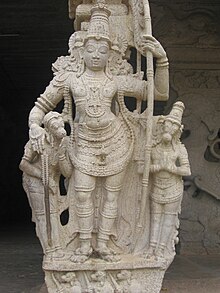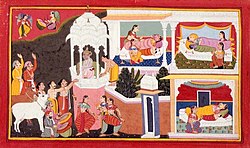Lakshmana
| Lakshmana | |
|---|---|
Valiant brother of lord Rama | |
 Lakshmana at Srivaikuntanathan Perumal temple | |
| Devanagari | लक्ष्मण |
| Sanskrit transliteration | Lakṣmaṇa |
| Affiliation | Avatar of Shesha |
| Abode | Vaikuntha, Kshira Sagara |
| Weapon | bow and arrows, dagger |
| Personal information | |
| Born | Ayodha |
| Died | Ayodha suryu river |
| Parents | Dasharatha (father) Sumitra (mother) Kaushalya (step-mother) Kaikeyi (step-mother) |
| Siblings | Shatrughna (brother) Rama (half-brother) Bharata (half-brother) Shanta (half-sister) |
| Spouse | Urmila |
| Children | Angada Chandraketu [1] |
| Dynasty | Raghuvamsa, Suryavamsa |
Lakshmana (Sanskrit: लक्ष्मण, IAST: lakṣmaṇa, lit. he who has the signs of fortune), also spelled as Laxman or Lakhan, was the younger brother of the god Rama and his aide in the Hindu epic Ramayana. He is also known by other names- Saumitra ( IAST: saumitra, lit. son of Sumitra), Ramanuja ( IAST: rāmānuja, lit. younger brother of Rama) and Bharatanuja ( IAST: bharatānuja, lit. younger brother of Bharata). He was the twin of Shatrughna.
Birth and marriage[]

King Dasharatha of Ayodhya had three wives: Kausalya, Kaikeyi and Sumitra. He performed a sacrifice to beget sons and as a result, his queens became pregnant. Lakshmana and his brother Shatrughna were born to Sumitra, while Rama and Bharata were born to Kausalya and Kaikeyi.[2]
In the Puranas, Lakshmana is described as an incarnation of Shesha, the multiple-headed nāga (serpent) upon whom rests the god Vishnu, whose avatar Rama is considered.
When sage Vishwamitra asked Rama to kill the demons in the forest, Lakshmana accompanied them and went to Mithila with them. Lakshmana was especially attached to Rama. When Rama married Sita, Lakshmana married Sita's younger sister, Urmila. They had two sons: Angada and Chandraketu.
Later, when Rama was exiled for fourteen years on the insistence of Kaikeyi, Lakshmana left his wife Urmila and joined Rama and Sita in exile.[2]
Rama's exile[]
Lakshmana served Rama and Sita reverently during the exile. In Panchvati, Lakshmana also built a hut for Rama and Sita to live in. Lakshmana cut off Ravana's sister Surpanakha's nose in anger when she tried to seduce Rama and insulted Sita. He played an important role in the war with Ravana and slew Ravana's sons Indrajit and Atikaya.
When Sita asked Rama to fetch a magical golden deer for her, Rama asked Lakshmana to stand guard as he sensed danger and evil. The golden deer was in fact the demon Maricha, who distracted Rama. When Rama killed Maricha, he cried out in his own voice for help. Although Lakshmana knew that Rama was invincible and beyond any danger, Sita panicked and frantically ordered Lakshmana to go to Rama's aid immediately. Unable to disobey Sita, Lakshmana drew a perimeter line (Lakshmana Rekha or Lakshmana's line), which Sita must not cross and went in search of Rama. Sita, however, out of compulsion of religious duty and compassion for Ravana, who was disguised as a poor brahmin, crossed the line to give him alms, following which she was abducted. Lakshmana Rekha has become a metaphor in situations where a certain limit must not be transgressed by human beings in any circumstance whatsoever.
During the war between Rama and Ravana, Lakshmana killed Indrajit and Atikaya, who were the sons of Ravana. Before he killed Indrajit, Lakhshmana and Rama were twice defeated by Indrajit, and on both occasions, Hanuman's intervention saved them from certain death.[3] After the war, when Rama asked Sita to give a test of her purity, Lakshmana for the first time got angry with Rama and opposed him.

Rama portrayed as a vanavasi (forest dweller) in the forest with his wife Sita and brother Lakshmana

Lakshamana cut Surpanakha's nose

Killing of Indrajit by Lakshmana
After exile[]

After the end of the Lanka war, Rama was crowned king of Ayodhya, and Bharata became the crown prince. Rama had offered to make Lakshmana the crown prince, but he refused, saying Bharata was elder than him and more deserving of the title. Rama, hearing this, was very pleased and said "O Lakshmana, in this birth, you served me so well and did your duties as a younger brother, so I will do the same in my next birth as your younger brother". Thus, in the next birth, Rama became Krishna and Lakshmana became Balarama, Krishna's elder brother.[citation needed]
Lakshmana was the one who left Sita in the forests near sage Valmiki's ashram after she expressed her desire to leave the kingdom. Lakshmana remained loyal to his brother and fought against Rama's sons Lava and Kusha later on.[citation needed]
Abandonment of life[]
Sage Durvasa appeared at Rama's doorstep, and seeing Lakshmana guarding the door, demanded an audience with Rama. At the time, Rama was having a private conversation with Yama. Before the conversation began, Yama gave Rama strict instructions that their dialogue was to remain confidential, and anyone who entered the room was to be relieved of their life. Rama agreed and entrusted Lakshmana with the duty of guarding his door. When Durvasa made his demand, Lakshmana politely refused. The sage grew angry and threatened to curse all of Ayodhya if Lakshmana did not immediately inform Rama of his arrival. Lakshmana, in a dilemma, decided it would be better that he alone die to save all of Ayodhya from falling under Durvasa's curse and so interrupted Rama's meeting to inform him of the sage's arrival. Durvasa cursed him that he should go to heaven alive. Rama quickly concluded his meeting with Yama and received the sage with due courtesy. In order to fulfil his brother's promise, Lakshmana went to the banks of the river Sarayu, resolved on giving up the world by drowning himself in the Sarayu. From there, Indra removed Lakshmana from the water and took him alive to heaven [4]
Legacy[]
Lakshmana was depicted by the Ramayana as a man with unwavering loyalty, love and commitment to his elder brother, through times of joy and adversity alike.
Bandhavgarh Fort at Madhya Pradesh (bandhav as brother, garh as fort) was said to have been given by Rama to his brother Lakshmana to keep watch on Lanka.[5]
Military officers given the rank equivalent of admirals in navies in the Malay Archipelago, including Malaysia and Indonesia, are titled "Lakshmana" (Jawi script: لقسامان) after the figure.
Descendants[]
The community members of an imperial dynasty of Gurjara-Pratiharas claimed that they were called Pratihara as their ancestor, who Lakshmana served as a door-keeper to his elder brother Rama. They ruled much of Northern India from the mid 7th to the 11th century. The first Pratihara inscription to discuss the origin of the Pratihara dynasty was the Jodhpur inscription of Bauka Pratihara 837 CE, It also gave its name to the dynasty, as the ancestors from Lakshmana, who worked as a gatekeeper for his brother Ramachandra. [6] [7] Laxman's son Angad, who was the ruler of Karpath (Rajasthan and Punjab), mention King Shri Harichandra Pratihara in the 126th generation of this dynasty (590 AD).
Jain version[]
Lakshmana is referred to as Vasudeva in the Jain Ramayana. According to the Jain Ramayana, it was Lakshmana who killed Ravana, not Rama.[8]
Notes[]
- ^ Ramayana – Conclusion, translated by Romesh C. Dutt (1899)
- ^ Jump up to: a b Mani, Vettam (1975). Puranic Encyclopaedia: A Comprehensive Dictionary With Special Reference to the Epic and Puranic Literature. Delhi: Motilal Banarsidass. pp. 448-9. ISBN 978-0-8426-0822-0.
- ^ B. A van Nooten William (2000). Ramayana. University of California Press. ISBN 978-0-520-22703-3.
- ^ "When Sri Rama gives death penalty to Laxman". News Track. 2 April 2020. Retrieved 17 June 2020.
- ^ Padmanabhan, Geeta (14 February 2018). "Holding fort at Bandhavgarh Wildlife Sanctuary". The Hindu. ISSN 0971-751X. Retrieved 2 July 2020.
- ^ K.M. Munshi Diamond Volume, II, p. 11
- ^ Epigraphia Indica, XVIII, pp. 87
- ^ "No exaggerations: The truth behind what happened in the Ramayana". The Indian Express. 10 November 2015. Retrieved 2 July 2020.
External links[]
 Media related to Lakshmana at Wikimedia Commons
Media related to Lakshmana at Wikimedia Commons
- Characters in the Ramayana
- Hindu gods
- Raghuvamsa
- Salakapurusa
- Descendants of Ikshvaku




